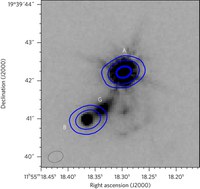Large-scale Magnetic Fields in a Distant Galaxy
Magnetic fields play a pivotal role in the physics of interstellar medium in galaxies, but there are few observational constraints on how they evolve across cosmic time. Spatially resolved synchrotron polarization maps at radio wavelengths reveal well-ordered, large-scale magnetic fields in nearby galaxies that are believed to grow from a seed field via a dynamo effect. To directly test and characterize this theory requires magnetic field strength and geometry measurements in cosmologically distant galaxies, which are challenging to obtain due to the limited sensitivity and angular resolution of radio telescopes.
In this work, Mao and her colleagues report the cleanest measurements yet of magnetic fields in a galaxy beyond the local volume, free of the systematics traditional techniques encounter. Using the Jansky VLA and exploiting the scenario where the polarized radio emission from a background source is gravitationally lensed by a foreground galaxy at z = 0.439, using broadband radio polarization data, the authors detected coherent micro-Gauss magnetic fields in the lensing disk galaxy as seen 4.6 Gyr ago, with similar strength and geometry to local volume galaxies. This is the highest redshift galaxy whose observed coherent magnetic field property is compatible with a mean-field dynamo origin.
Image: The 5 GHz total intensity radio contours from the Jansky VLA superposed on a Hubble Space Telescope visible (F814W) image of the gravitational lensing system CLASS B1152+199.
Publication: S. A. Mao (Max Planck Institute for Radio Astronomy) et al., Detection of Microgauss Coherent Magnetic Fields in a Galaxy Five Billion Years Ago, 2017, Nature Astronomy, 1, 621 (28 August 2017)





Connect with NRAO